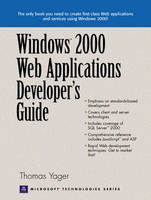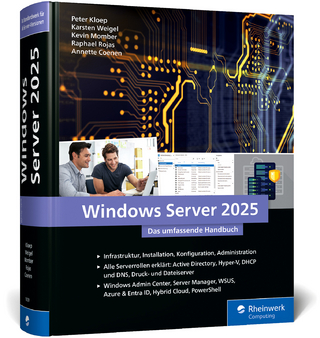
Windows 2000 Web Applications Developer's Guide
Prentice Hall (Verlag)
978-0-13-022992-2 (ISBN)
- Titel ist leider vergriffen;
keine Neuauflage - Artikel merken
PLEASE PROVIDE
Now, there's a single source for developers and managers who need to deliver robust, standards-compliant Web applications with Microsoft's latest technologies -- including Windows 2000 and Internet Information Server 5.0. From start to finish, Thomas Yager offers practical, objective guidance every enterprise Web developer and manager needs now. Coverage includes: How to match hardware to application needs; defining multi-tier architectures; planning for browser compatibility; and building a development environment. Yager covers every key Microsoft technology, including Windows 2000, Internet Information Server 5, Visual InterDev 6, ASP, the not-yet-released SQL Server 2000, COM, ActiveX, and ADO -- as well as external standards such as XML, DHTML, and Java. He offers objective advice on integrating third-party technologies, showing how to build 100% standards-compliant Web applications that maximize flexibility for years to come. Succinct, objective, and thorough, Windows 2000 Web Applications Developers Guide is the only guide Windows Web developers and managers need.
THOMAS YAGER is a Senior Analyst for InfoWorld magazine. Prior to joining InfoWorld, he was instrumental in the design and development of several large-scale, commercial Web and Internet-enabled applications. Thomas has written hundreds of articles for prominent computer magazines, and he has published two computer technology books in addition to this one.
1. Windows 2000 as a Web Applications Platform.
Where Web-based Fits In. What's New in Windows 2000. Windows 2000 in a Heterogeneous Environment. The Browser's Role. The Deployment Dilemma. Summary.
2. Internet Information Services 5.0.
IIS 5's Default Setup. Virtual Directories, Sites and Applications. Virtual Directories. Sites. Applications. Using Web Folders. Summary.
3. Early Planning and Design Considerations.
Are We Ready for This? Server-based. Network-intensive. Software Licensing. Security and Privacy. Availability and Reliability. Charting Your Project's Course. Operating System Choices. Designing for Reuse. Concern for the Environment. Three-Tier and n-Tier Design. Three Tiers, Four Tiers and More Tiers. Summary.
4. The Development Environment.
The Web Developer's Workstation. Standardizing Development Software. Staging Development and Release. The Role of Servers in the Staging Process. Collaboration and Source Code Control. Summary.
5. The Web-based Client.
The Browser as Platform. Traditional Techniques in a Web World. File I/O. Windows and Dialogs. Menus and Accelerators. Custom and Owner-drawn Controls. Device and Process Control. Windows System Calls. The Dialog Editor. The Text/Debugging Console. Exception Handling. Help!I Can't Deal with All These Restrictions! On the Server Side of the Street. Where's the Line? Argument and Return Value Passing. Summary.
6. The Database.
SQL Server 7 and 2000. Database Alternatives. Database Design for the Impatient. Creating the Database. A Sample Database Layout. Defining a New ODBC Connection. Using Visual Studio to Design a New Database. Summary.
7. Visual InterDev and Visual Studio.
Design-Time Controls. Building a Script Library Project. Visual InterDev's Editing Modes. Using Design-Time Controls. Project Management in Visual InterDev. Project Organization and Synchronization. Activating and Using Visual SourceSafe. The Visual Studio Source Code Editor. Summary.
8. Back to HTML.
The Letter of the HTML Law. The Minimal HTML File. Comments. Simple Text Formatting. Hyperlinks. Images. Indented Text. Lists. Tables. Frames. Editing HTML in Visual InterDev. HTML Forms. Summary.
9. Cascading Style Sheets.
CSS Versions and Browser Compatibility. Introduction to CSS. Classes, Pseudo-classes and Pseudo-elements. CSS2 Selector Syntax. Applying Style Sheets and Individual Styles. Vertical and Horizontal Placement. Using DIV and SPAN Elements. Flow-altering Properties: Display, Visibility and Float. Colors, Borders and Backgrounds. Borders, Margins and Padding. About Transparency. Z-order. Fonts and Spacing. Text Placement. The @media Rule and Paged Media. Summary.
10. JavaScript.
Specifying JavaScript. Syntax Rules. Core Data Types. Arrays. Functions. Scope. User-defined Objects. Altering Objects Outside the Constructor. Exception Handling. Microsoft JScript Version 5.5. String Replacement Functions. Regular Expression (RegExp Object) Changes. Perl-style “Dollar Variables”. Numeric and Locale-sensitive Formatting. JScript Custom Object Enhancements. Uniform Resource Identifier Encoding and Decoding. Array Handling. Exception Handling. Date Formatting. Using JScript 5.5. Summary.
11. The Document Object Model and Dynamic HTML.
The DOM: A High-Altitude View. The DOM JavaScript Bindings. Help from Visual InterDev. Reading and Setting Properties. Attributes Versus Styles. DHTML Events. Sensible Use of Keyboard and Mouse Sensitivity. Defining Event Handlers. Event Bubbling and Return Values. Capturing Mouse Events. Drag and Drop. Communication Between Windows. Changing HTML in Script. Modifying Tables. DHTML Behaviors and Dynamic Properties. A Default Behavior: userData. User-defined Behaviors. Dynamic Properties. Summary.
12. XML.
Introduction to XML. XML Syntax. Using XML Documents. The XML DOM. Navigating with DOM Objects. Extracting Specific Nodes. Adding Nodes to an XML Document. XSL Patterns. XSL. XML Namespaces. Using XSL to Produce HTML. XML DTD. DTDs Without Fear. Do You Need a DTD? A DTD Design Strategy. DTD Layout Considerations. Defining XML Elements. Defining Attributes. Entities. The Complete Invoice Header DTD. Summary.
13. COM and COM+.
Introduction. COM and the Client. VB and Java. The Platform SDK and MSDN Library. How COM Works. Finding an Object. COM Identifiers and the “COM Contract”. In-process, Out-of-process and Remote Servers. Threading Models. Using Existing COM Objects. Making Sense of It. Destroying COM Objects. Script Components As COM Servers. Introducing Script Components. Component Registration Details. Generating Your Type Library Automatically. Registering Your Component. The Component's Public Interface. The Complete Script Component Example. Handling Errors the COM Way. Firing and Sinking Events. Using Callbacks. COM+. COM+ and ASP. COM+ Fundamentals. Transaction Services. Resource and Object Pooling. Security. Events. Queued Components. COM+ Load Balancing. In-Memory Database (IMDB). DCOM. Registering DCOM Components. COM Internet Services (HTTP Tunneling). SOAP. The Practicality of DCOM. Summary.
14. Server Script Programming.
Making Connections. Maintaining Session State. Application State. ASP Syntax. ASP Parameter Overrides. ASP Script Blocks. How ASP Handles Multiple Server Script Blocks. Server-side Includes. Exposing the ASP Object Model to Script Components. Conditional HTML. The ASP Object Model: Application and Session. The GLOBAL.ASA File. Coding for Application and Session Events. Creating Application and Session-scope Objects. The Server Object. Server.Execute(). Server.Transfer(). Server.MapPath(). Server.URLEncode() and Server.HTMLEncode(). The Request Object. Request.Form(). Request.QueryString(). Request.Cookies(). Request.ServerVariables(). The Response Object. Response.Clear(), Response.End() and Response.Flush(). Response.Redirect(). Response.IsClientConnected(). Response.PICS(). Summary.
15. Database Access in SQL Server.
A Transact-SQL Primer. Transact-SQL By Hand. Common SELECT Queries. Querying Multiple Tables. Inserting, Updating and Deleting Rows. What Now? Active Data Objects. ADO Objects. Establishing a Connection. Executing a Command. Recordsets and Cursors. Connection Pooling. An ADO Sample. The Fields Collection. Recordset Persistence. Stored Procedures, Views and Triggers. Stored Procedures. Views. Triggers. Section Summary. SQL Server 2000. User-defined Functions. Generating XML Documents from Queries. INSTEAD OF Triggers. Cascading Table Changes. Multiple Instances of SQL Server. Summary.
16. Windows 2000 Middleware.
Transactions in Action. Transactions in ASP. Transactions Across Multiple Pages. Transactions with Script Components. Transaction Components in C++. ObjectContext Versus ContextState. Abort/Complete Versus Enable/Disable. Building a C++ COM+ Transaction Component. Creating a New COM+ Application. Registering and Configuring a COM+ Component. Testing a C++ Transaction Component from ASP. Does It Have to Be This Difficult? Message Queuing. Disconnected Tiers. Message Queuing and MOM. Message Queuing Overview. Message Queuing Servers and Clients. Configuring Message Queuing. Queues in ASP. Advanced Queuing. Queued Components. Rules For Creating COM+ Queued Components. Calling a Queued Component. Section Summary. COM+ Publish and Subscribe (COM+ Events). Building a COM+ Events Event Class in Visual C++. Registering Your Event Class with COM+. Building a COM+ Events Subscriber Component. Registering a COM+ Events Subscriber Component. Testing COM+ Events with an ASP Publisher. Summary.
APPENDIX A: JavaScript Language Reference.
Conventions. Statements. Conditional Compilation. Objects. JavaScript Operators. Regular Expressions.
APPENDIX B: HTML Rapid Reference.
Conventions. Elements.
APPENDIX C: Microsoft DOM Rapid Reference.
Internet Explorer 5 DHTML DOM. Microsoft XML DOM.
APPENDIX D: ASP Object Model Rapid Reference.
APPENDIX E: Source Code, Updates and More 601 www.WindowsWebApps.com.
INDEX.
| Erscheint lt. Verlag | 10.5.2000 |
|---|---|
| Verlagsort | Upper Saddle River |
| Sprache | englisch |
| Maße | 178 x 235 mm |
| Gewicht | 1196 g |
| Themenwelt | Informatik ► Betriebssysteme / Server ► Windows |
| Informatik ► Betriebssysteme / Server ► Windows Server | |
| Mathematik / Informatik ► Informatik ► Web / Internet | |
| ISBN-10 | 0-13-022992-X / 013022992X |
| ISBN-13 | 978-0-13-022992-2 / 9780130229922 |
| Zustand | Neuware |
| Informationen gemäß Produktsicherheitsverordnung (GPSR) | |
| Haben Sie eine Frage zum Produkt? |
aus dem Bereich


